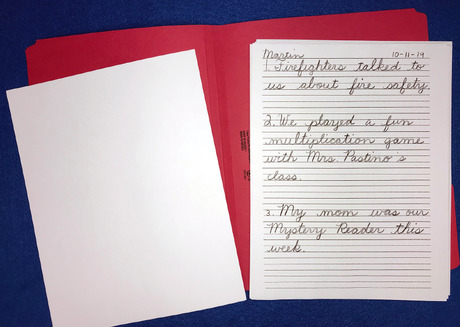 For years, my handwriting was mostly printed with a smattering of cursive tossed in. Then I took a dive in some platform heels and sprained my thumb. Subsequently, my printing became awkward and painful so I decided to brush up on my cursive, assuming that it would be easier on my hand. I was right. The glide of cursive across the page is less jarring and quicker to produce. And let’s be honest, it looks fancy. I had forgotten how much I like cursive writing!
For years, my handwriting was mostly printed with a smattering of cursive tossed in. Then I took a dive in some platform heels and sprained my thumb. Subsequently, my printing became awkward and painful so I decided to brush up on my cursive, assuming that it would be easier on my hand. I was right. The glide of cursive across the page is less jarring and quicker to produce. And let’s be honest, it looks fancy. I had forgotten how much I like cursive writing!
We all know that cursive isn’t taught in every school anymore. And there have been surprising repercussions. For example, printing is easily forged. So signing a legal document with your printed name can leave people open to security risks (see more on that here). In addition, people who can’t write cursive generally can’t read it. And that makes historical documents equivalent to a foreign language.
Maybe it’s for those reasons, but I’ve noticed that cursive instruction seems to be on the upswing in schools. So it’s appropriate that I include a neat cursive activity with this blog. Happy writing!

Students recap the week, practice cursive handwriting, and contribute to a year-end keepsake, all with this one idea.
Directions:
- Each Friday, ask students to recall special school-related events from the past week. Write their ideas on the board in complete sentences.
- Direct each student to write on a sheet of handwriting paper his name and the date. Then have him copy three or more of the displayed sentences in his best cursive handwriting.
- Collect the papers and file them in individual student folders.
- At the end of the year, help each child chronologically compile his weekly reflections into a booklet. Not only will each student have firsthand evidence of his handwriting progress, but he’ll have a wonderful keepsake of special memories too.

We have so much new curriculum but I always go back to my mailbox resources because they make learning fun. Not much of the new stuff is fun. I think kids are a tad disgruntled with school because it’s no fun.
We recently had a vision therapist presentation and she said that the formation of cursive letters is not only important for the correct formation of printed letters but is important for the eye learning to track from left to right which is an important skill that transfers to reading.